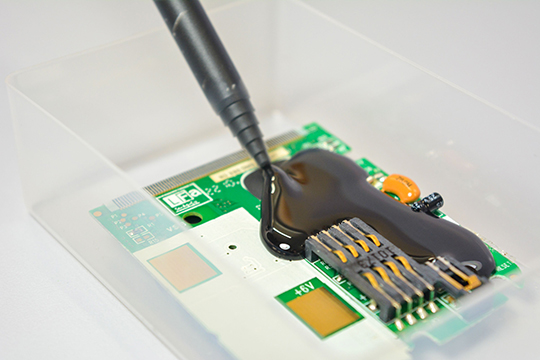
Posted to News on 7th Jun 2023, 10:16
Three worked examples of potting PCB assemblies

Darren Rea, sales executive of adhesives supplier Intertronics, discusses three recent potting examples, sharing details on the different properties of available materials.
Potting is a common method to protect PCB assemblies, which involves filling an enclosure with a liquid material to protect the board and its electrical components. Depending on the application’s needs, there are a wide range of potting compounds available in a variety of formulations, including low density/lightweight, flame retardant, flexible, optically clear, and thermally conductive.
Silicone, epoxy, polyurethane, and UV/visible light cure potting compounds are designed to protect sensitive components such as printed circuit boards, automotive electronics, control boxes, and cable joint assemblies from vibration, high humidity, or other harsh environmental conditions. It can be challenging to know which material to specify, due to the variety of chemistries, which offer different physical and electrical properties and have differing processing requirements.
PCBs in remote control devices
When a manufacturer of wireless remote control devices was looking for a way to pot electronic components on an FR4 circuit board into a moulded clear polycarbonate enclosure, it opted for Wacker Elastosil RT 601. This material is an optically clear, low viscosity silicone potting compound that offers temperature resistance from -40°C to 130°C in both indoor and outdoor environments.
The material cures at room temperature via a two-part addition cure, at 23°C for 24 hours at a 1 cm potting depth, negating the need for expensive ovens. Another benefit of this material is that its transparent nature makes inspecting the potted PCB assembly easy. The manufacturers found that this semi-flexible material provided the required environmental protection and shock resistance to the finished product, protecting the assemblies from vibration.
Electronics modules for on-vehicle use
A manufacturer of electronic modules for automotive applications opted for Intertronics IRS 2040-1 Epoxy Potting Compound to pot an FR4 board and its electronic components to ABS moulding. Its aim was to protect sensitive electronics from a harsh environment near the engine.
IRS 2040-1 is a non-toxic, general purpose material selected due to its flame retardant properties (to UL94 V-0 at 3 mm), high electrical insulating characteristics, and good thermal conductivity. The material offers excellent adhesion to most plastic and metal substrates, alongside the fuel and oil resistance required for the automotive environment. IRS 2040-1 is compatible with most PCB components and materials over a wide range of temperatures (offering a potential -55°C to +130°C operating temperature).
This material has a long pot life and can be cured at ambient temperature (typically at 20°C for 48 hours), although this can be accelerated with heat. When cured, IRS 2040-1 exhibits high electrical strength, good thermal conductivity, low exotherm, and low cure shrinkage. The black material cures to a gloss finish, meaning no aesthetic casing was required.
Tyre pressure sensor potting
During the manufacture of tyre pressure monitoring sensors, a manufacturer was looking for a way to protect its FR4 circuit board and electronic components from chemicals, fluid, and shock. It decided to pot into an ABS moulding, using Intertronics IRS 2012-1 Epoxy Potting Compound to protect the sensors without adding significant weight. This very low density formulation is typically used in systems where weight is critical, such as auto sport, motor racing, and aerospace. Alongside its low density, the material has excellent electrical properties and offers chemical resistance to solvents, oils, fuels, acids, bases, and hydraulic fluids.
The material was supplied in pre-measured twin-packs to simplify the production process, and can be cured at 23°C for 24 hours, without the need for curing ovens. The cured product offered the required chemical and fluid resistance, shock resistance, and temperature resistance of -40°C to 60°C. In addition, the final product had good transparency to RD and radio signals due to the properties of IRS 2012-1, important for a sensor of this kind.
Want the latest machine building news straight to your inbox? Become a MachineBuilding member for free today >>















